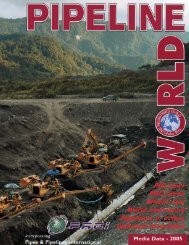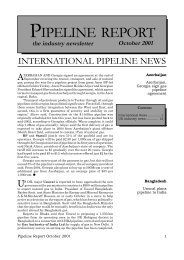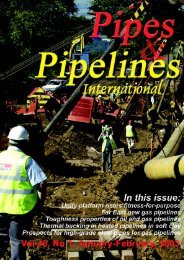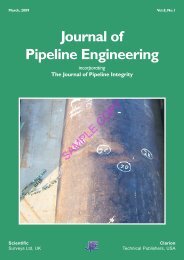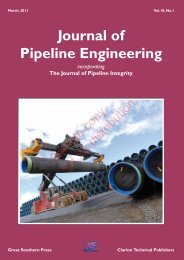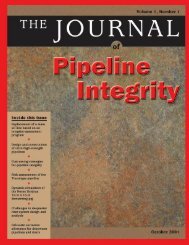JPE - Sept09 - cover2-4.pmd - Pipes & Pipelines International ...
JPE - Sept09 - cover2-4.pmd - Pipes & Pipelines International ...
JPE - Sept09 - cover2-4.pmd - Pipes & Pipelines International ...
Create successful ePaper yourself
Turn your PDF publications into a flip-book with our unique Google optimized e-Paper software.
168<br />
Fig.1. The planned route of the Nord Stream project.<br />
approximately 70% of the first pipeline’s pipes have already<br />
been manufactured. Eupec Pipe Coatings of France will<br />
provide the complete pipe logistical and supply services,<br />
including the concrete weight coating of the pipes. Two<br />
brand-new concrete-coating plants have been built to service<br />
the vast quantity of pipe, one at Mukran on the island<br />
Rugen, Germany, and one at Kotka in the Gulf of Finland.<br />
The Baltic Sea is a highly-sensitive ecological region and, as<br />
a result, Nord Stream AG has carried out extensive and<br />
detailed environmental impact studies and environmental<br />
planning to ensure that the design, installation, and<br />
operation of the pipeline will be environmentally sound.<br />
Construction of pipeline 1 (the North West line) is planned<br />
to start in April, 2010, with first gas expected by September,<br />
2011. The full transport capacity of approximately 55 bcm/<br />
yr will be available on completion of pipeline 2 (the South<br />
East line) in November, 2012.<br />
Technical aspects/data<br />
System design<br />
The pipeline has been designed in accordance with DNV<br />
OS-F101 2000, Rules for submarine pipeline systems, including<br />
the January, 2003, Amendment and corrections. Additionally,<br />
in Germany the DIN - EN 14161 Petroleum and natural gas<br />
industries: pipeline transportation systems (ISO 13623:2000<br />
modified) code has also been satisfied due to authority<br />
requirements. However, should DIN EN 14161 and the<br />
DNV F101 code be in contradiction with each other, then<br />
the DNV code takes priority.<br />
Each of the pipelines will have a transport capacity of<br />
approximately 27.5 bcm/yr of natural gas at reference<br />
conditions of 20°C and 1atm, and the system’s design life<br />
is 50 years.<br />
The Journal of Pipeline Engineering<br />
The pipeline system’s limits are defined as between the pig<br />
launcher and the pig receiver at the Russian and German<br />
landfalls, respectively.<br />
The fundamental design of the Nord Stream pipelines was<br />
based on several factors, including the steady-state and<br />
transient flow operating conditions and overall<br />
environmental, economic, and commercial optimization.<br />
This resulted in dividing the pipeline’s overall length of<br />
1,223km into three MAOP (maximum allowable operating<br />
pressure) sections, as shown in Table 1.<br />
Pipe data<br />
Sample issue<br />
• nominal size = DN 48in (DN1200)<br />
• constant internal diameter ID = 1,153mm<br />
• pipes with longitudinally-welded seams (submergedarc<br />
welding) with an individual pipe length of<br />
approximately 12.2m<br />
• pipe material SAWL 485 I DF according to DNV<br />
standard OS-F101 with the following characteristic<br />
values:<br />
minimum yield strength = 485N/mm²<br />
modulus of elasticity = 2.07 x 10 5 N/mm²<br />
transverse contraction number = 0.3<br />
thermal expansion coefficient = 1.16 x 10 -5 /°C<br />
density = 7,850 kg/m³<br />
External coating<br />
The three-layer anti-corrosion coating was designed in<br />
accordance with ISO 21809-1 External coatings for buried or<br />
submerged pipelines used in pipeline transportation systems.<br />
Designed to a minimum thickness of 4.2mm, it consists of:<br />
• first layer: approximately 0.15mm of FBE (fusionbonded<br />
epoxy)



